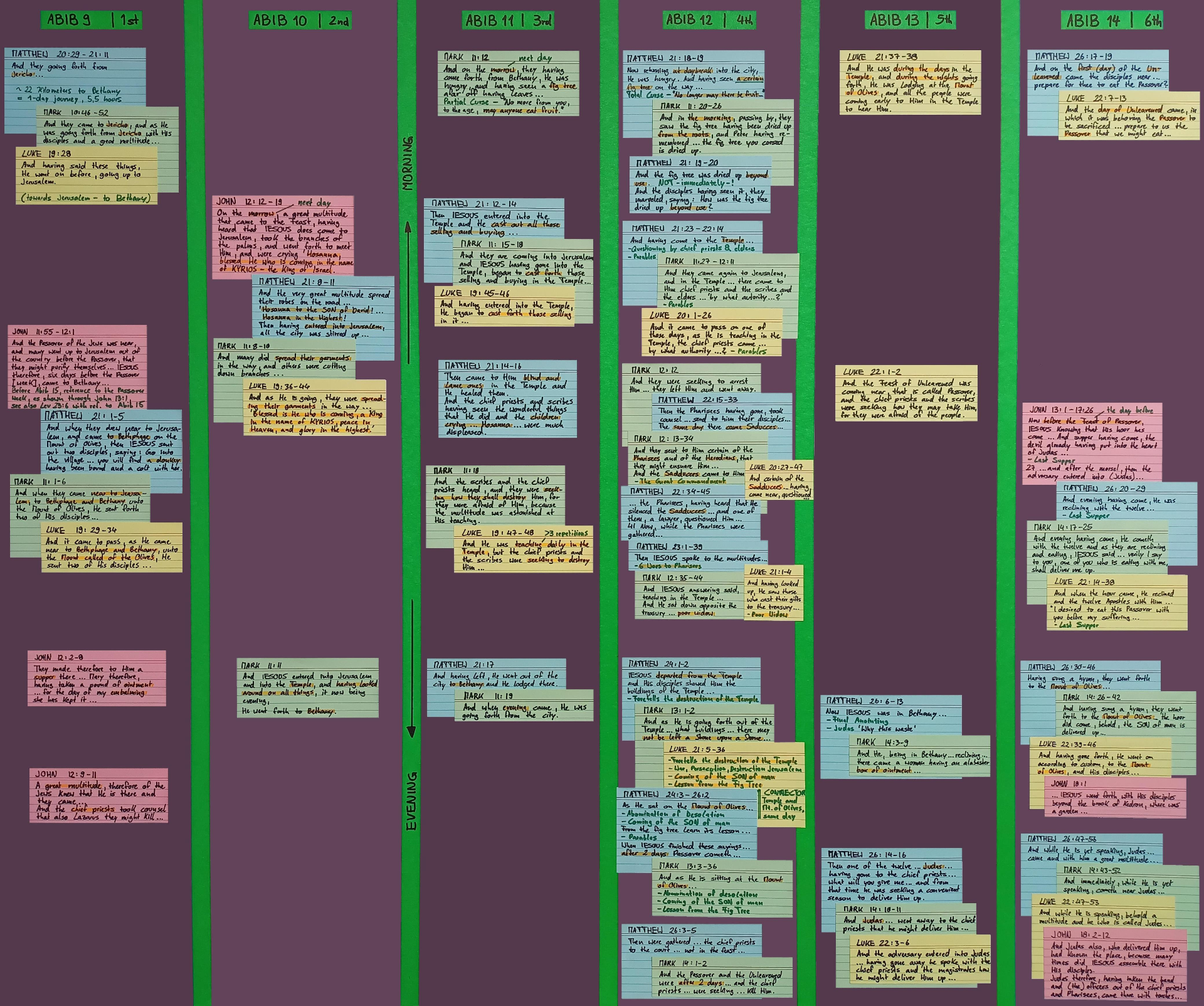Passover


IESOUS did not suffer a fast-track-trial & crucifixion, but died on day 6 of Passover. The following conditions lead to this precise conclusion, and are found in much greater detail in the study 'CHRISTOS IESOUS 〣 Passover Chronology · Refutation of Fast-Track Trial':
- The First Day of the Month follows the New Moon ('Waxing Crescent').
- A biblically defined day does not start in the evening (according to Jewish Mainstream which also twists the beginning of a year), but always at sunrise. Proof passages are 1Sam 19:11, Joh 20:19 and Act 4:3. Exceptions: 2 out of 7 Sabbaths of Sabbaths (at least Day of Atonement Lev 23:32 and Passover Deut 16:6) started at sunset, but this special timing does -NOT- affect the Weekly Sabbath or any ordinary weekday.
- IESOUS taught "every day in the Temple" (a wording which means at least 3 times from Abib 11th (Tue); Abib 10th only with a brief visit). Luk 19:47
- The Passover Lamb was always to be eaten on the evening of Abib (Nisan) 14th. Exo 12:6, 10, 18, Lev 23:5, Num 9:1-5, 28:16, 2Chr 35:1-14, Eze 45:21
- IESOUS definitely ate the Passover Lamb on the evening of Abib 14th. Mat 26:17, 20, Joh 13:1-2
- The 3 non-Jewish trials must have been held without touching the idolatrous day of 'Ides' on Abib 15th, when political and judicial activities were strictly prohibited for both Pilate and Herod.
- At least one -full- night must have legally passed before the death sentence was carried out.
- IESOUS died on a 'Day of Preparation'. Joh 19:31
- IESOUS died after Judas (logically no resurrection while Judas was still decaying on the open field).
- IESOUS died during Passover in order to typify the LAMB. This typology does not require His death on the evening of the Passover Lamb, but anytime during the 7 days. Joh 1:29, 1Cor 5:6-8
- His body must have been taken down before sunset. Deut 21:22-23, Jos 10:26-27
- IESOUS remained 3 days in the tomb (~6 hrs after sunset + 24 hrs + 24 hrs + ~6 hrs until sunrise). Mat 12:40
- IESOUS remained 3 nights in the tomb. Mat 12:40
- IESOUS remained during 2 consecutive Sabbaths in the tomb (1 Sabbath of Sabbaths & 1 Weekly Sabbath), which is clearly proven by the burial spices purchased in between. Luk 24:1-21, Joh 19:31
- The women purchased burial spices after the first Sabbath was over (the markets opened in the evening) and prepared those before the second Sabbath started the next morning. Mar 16:1, Luk 23:55-56
- IESOUS resurrected on the first day after the Sabbath (modern Sunday). Luk 24:1-2
- IESOUS resurrected at the dawn of the third day -since- His crucifixion. Luk 24:2-21
- IESOUS must have resurrected on, or in between the Day of First Fruits (Abib 23rd according to Beta Israel; usually assumed with Abib 16th) and the Feast of Harvest (+ 50 days) in order to typify the First Fruit. 1Cor 15:20
- IESOUS resurrected -after- and not during the Feast of Unleavened Bread in order to typify the Bread of Life. Mat 13:33
- The most evident point is the fact that CHRISTOS would have impossibly risen and resurrected in a time biblically declared as time of affliction (what the Unleavened Bread specifically stood for). He died in the time of affliction and resurrected immediately after this time. Deut 16:3, Isa 53:4-7
- The day of His resurrection must have coincided with the return travel of the visitors -after- the Passover week. IESOUS did -NOT- appear to two unfaithful travelers who left the Passover one entire week too early. Luk 24:13-21
- The return travel after the Passover Week must have coincided with the return travel of the Feast of Tabernacles. Both Passover and Tabernacles started officially on the 15th, and the return travel occurred in both cases on the 23rd of the respective month. 2Chr 7:10

Those conditions have never been fulfilled by any known Bible study, but are fulfilled in its entirety by the following study.

